- Influence of ceramic waste powder (CWP) in strength and durability performance of coir fiber reinforced concrete
S. Anandaraja,*, A.R. Krishnarajab, P. Kulanthaivelc and P.C. Murugand
aAssistant Professor, Department of Civil Engineering, KPR Institute of Engineering and Technology, Coimbatore – 641 407, Tamilnadu, India
bAssociate Professor, Department of Civil Engineering, Kongu Engineering College, Perundurai-638060, Tamilnadu, India
cAssistant Professor, Department of Civil Engineering, Kongu Engineering College, Perundurai-638060, Tamilnadu, India
dAssociate Professor, Department of Automobile Engineering, Kongu Engineering College, Perundurai-638060, Tamilnadu, IndiaThis article is an open access article distributed under the terms of the Creative Commons Attribution Non-Commercial License (http://creativecommons.org/licenses/by-nc/4.0) which permits unrestricted non-commercial use, distribution, and reproduction in any medium, provided the original work is properly cited.
Concrete is stable in compression but frail in tension. For eliminating the problem, we introduce fibers in the concrete. Ceramic waste powder, when finely ground, can exhibit pozzolanic properties and the coir fiber acts as a natural fiber. Utilizing ceramic waste powder as an additional cementitious ingredient can be advantageous for the environment and the economy. A budgetary and sizable plain concrete can be advanced via the unreal of normal Portland cement with ceramic waste powder. Coir fibers in concrete influences a lesser amount of compressive strength and higher amount of tensile strength. An investigation is accomplished to test the opportunity of the inclusion of ceramic waste powder as partial cement replacement and coir fibers were introduced to improve the tensile properties in the concrete. In this study, cement is substituted with ceramic waste powder in amounts of 0%, 20%, 40%, 60% and 80%. A preliminary investigation revealed that using 20% ceramic waste powder in place of cement improved the properties of concrete's strength. Further research reveals that concrete with 0, 0.5%, 1% and 2% coir fiber addition in the concrete with constant 20% ceramic waste powder. Results shows 1% coir fiber addition and 20% ceramic waste powder as cement replacement achieved the strongest qualities compared to control concrete. In comparison to the other specimens, the combination of coir fibers with ceramic waste powder improves the strength properties.
Keywords: Ceramic waste powder, Concrete, Cement, Coir fiber.
A common building material, concrete is effectively used in a various project, including highways, bridges, dams, and other structures. Several factors contribute to the demand for concrete. Although consumption of concrete has fueled economic growth and progress, environmental considerations must also be taken into account. Energy is used up during the manufacture of concrete, which increases carbon dioxide emissions. Generation of waste materials from the construction industry also has increased drastically adding to an increased environmental impact [18]. In order to lessen the environmental impact of concrete consumption, there has been an increase in interest in sustainable construction practices, such as the use of alternate cementitious materials, improved mix designs, and better construction methods. Amr S. El-Dieb and Dima M. Kanaan [1] said that, when it comes to the CWP’s effects on the environment, getting rid of it will be extremely difficult. Maximum researchers have looked into the results of employing ceramic wastes as coarse aggregates and supplementary cementitious materials in concrete and mortar mix. Harikaran et al. [2] identified that the ceramic and construction industries account for a sizeable portion of the world’s construction and demolition trash. In this project, ceramic waste is employed as one of the concrete’s constituents to reduce this waste and enhance the material’s engineering properties. Shuying et al. [3] said that two main development directions are reducing environmental pollution and recycling ceramic waste to protect the environment. Based on the findings of previous studies on ceramic waste as well as experimental research on the use of ceramic waste in concrete, it is possible to see how fly ash, another waste product, has been used in the past. Janani et al. [17] analyzed the mechanical and durability properties of the green concrete mixture prepared by using Waste Ceramic Tile Powder (CTWP) and Recycled Fine Aggregate (RCFA) at various replacement proportions and concluded the optimum replacement level for CTWP and RCFA at 30% and 100% respectively. Li et al. [4] concludes that according to estimates, 20% cement replacement with micro ceramic powder results in a 9.6% increase in concrete production efficiency and a 6.62% decrease in the specific energy used to produce cement. Meena et al. [5] concluded that using ceramic waste powder in the production of concrete mixture is lucrative in terms of generating cheap and durable and resolving environmental issues. Considering the environmental impact caused by the production and wastage of construction materials, Qiuying Chang et al. [20] investigated the possible cement replacement with waste ceramic powder and its impact on the various strength parameters of concrete using Machine Learning and evaluated the reduction in the impact on environmental factors on using optimal replacement level. In addition, Jianyu Yang et al. [21] used both AI and ML technology in efficiently analyzing the concrete characteristics on replacement of cement partially with waste ceramic powder and concluded the optimal replacement level for UPV as 10%. [16] also investigated the scope of employing industrial waste materials like fly ash in the production of low cost ceramic membrane which can be used for efficient treatment of Ground water. On the strength of the concrete, the impact of waste ceramic use was investigated. Mechanical qualities will be increased by replacing cement with waste ceramic. This gets worse as the amount of ceramic waste increases. Tanash et al. [19] examined prior research on the use of ceramic tile powder waste as a replacement for cement and aggregate in concrete and determined that CTA has a high water absorption capacity, lowering the concrete workability. However, the mechanical qualities of concrete appeared to improve with up to 30% coarse aggregate substitution and 60% fine aggregate replacement. In terms of cement composites, a 20% replacement with ceramic tile waste improved mechanical and durability qualities and was recommended for numerical analysis. Anandaraj et al. [6] said that in addition to the benefits of waste management, the increasing cost of traditional cementitious materials also encourages the use of alternative resources for the manufacturing of concrete. Ceyhun Aksoylu et al. investigated the impact of ceramic waste powder on the flexural behavior of reinforced concrete and concluded that 10% was the optimum replacement level for cement beyond which there was a considerable decrease in the load carrying capacity and ductility [23]. Sivabalaselvamani et al. [13] said that in field applications, ceramic wastes can be used as a soil stabilizing substance. Adamu Beyene et al. studied the suitability of ceramic waste dust as a stabilizing agent to modify the geotechnical properties of highly plastic subgrade and demonstrated the possibility of improving the stability of soil with CW at 20% as the optimum value [22]. Suchithra Shanmughan et al. [14] was found that using ceramic waste in the construction industry not only helps to achieve sustainability but also lowers the cost of construction materials. Further, Benamar Balegh et al. suggested the usage of ceramic waste powder as a reinforcing material for tuff modification [24].
Babar Ali et al. [7] said that due to CO2 emissions, the large-scale manufacture of artificial fibers has a negative effect on the environment. Fatema et al. [15] said that as the fiber content rises, porous ceramics’ physical qualities and mechanical strength also rise. As a result, much effort is being undertaken to evaluate different environmentally acceptable fiber options like waste and natural fibers. The most resilient natural fiber among all-natural fibers is coir, which is lightweight and natural. Coir fiber is one of the most extensively studied natural fibers compared to other natural fibers like jute, sisal and banana fiber in supplementary cementitious materials. Bo Wang et al. [8] has concluded that coir fiber has high elongation during tensile and a low embodied carbon footprint. Because of this, coir fiber is the perfect fiber to use in place of other fibers (such as steel, glass, and carbon fiber) to create monofilament fiber reinforced cement-based composite. Coir fiber has a bilinear stress-strain response when under tension.
Habibunnisa Syed et al. [9] concluded that when using a 0.40 aqueous water cement ratio and adding 0.6% and 1.2% coconut, the compression strength test produces positive outcomes. Adewumi John Babafemi et al. [10] demonstrated that concrete that has coir fiber added to it is more resistant to sulphate attack in terms of mass loss and strength loss; Concrete resistivity was increased with 1% Coir fiber addition.
The research study’s goals are to ascertain the strength characteristics of concrete utilizing CWP as a partial substitution for cement in an effort to eradicate ceramic waste from production industries. The novelty in this research area includes examining and taking advantage of the possible mutual enhancement that can exist between coir fibers and ceramic waste powder. The complimentary nature of these materials in terms of mechanical strength and durability may result in improved performance from the combination. Potential novelties are synergistic effect and Crack resistance and Self-healing properties are examined by the new combination of ceramic waste powder incorporated with coir fibers in the concrete.
Materials
The cement utilized in this study, grade 53 Ordinary Portland Cement, was purchased from a retail location in the region of Tirupur district. According to the Indian Standard Code, the cement’s specific gravity, specific surface, fineness of cement, and consistency limit are 3.10, 3260 cm2/g, 3.2%, and 29%, respectively. River sand served as the fine aggregate and it is collected in Coimbatore. The results are presented in Table 1 and Indian Standard was used to establish the physical parameters of river sand. The coarse aggregates had a nominal maximum sizes 20 mm. The results of the physical parameters of coarse aggregate are shown in Table 1. The ceramic waste powder was collected in ultra-pavers & Tiles manufacturing unit near vadavalli Coimbatore. The chemical composition of ceramic waste powder is outlined in Table 2. The waste powder generated from crushed ceramic waste is shown in Fig. 1. Specific gravity of ceramic waste powder is 2.86 and consistency limit was about 32%. The physical properties of cement and ceramic waste powder are nearby values. It shows that, CWP was a perfect replacement for cement. Table 2 shows the chemical composition of CWP as a substitution of cement. A brown colored coir fibers with diameter of 0.5 mm and length of fiber of 30 mm with an aspect ratio of 60 was used during the production of concrete. The coir fiber collected from udumalpet region and it is shown in Fig. 2.
Mix design
Designing M25 grade concrete mixtures was done in accordance with IS 10262's instructions. Implementing a 0.45 w/c, a mix percentage of 1:1.53:2.72 indicating cement, sand, and gravel was employed. Volume-based material batching was used to manage aggregate parking.
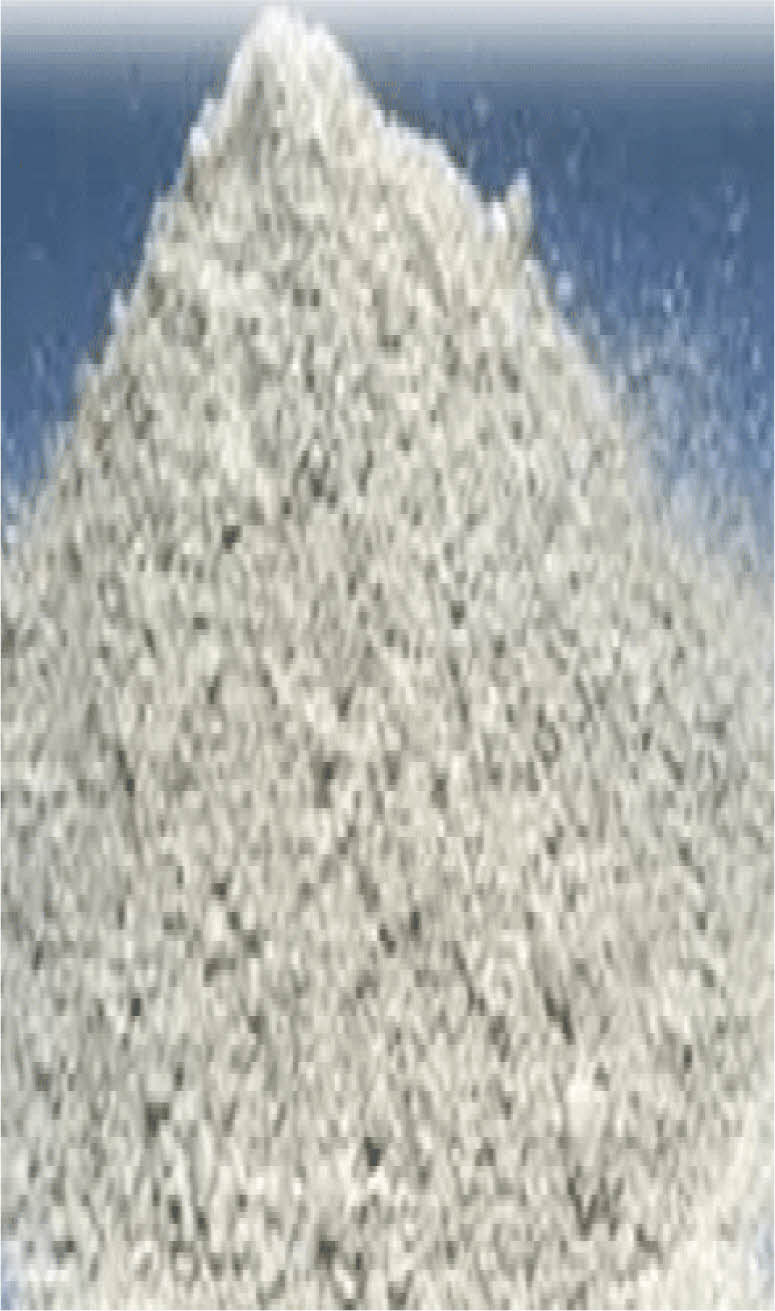
|
Fig. 1 Ceramic waste powder. |
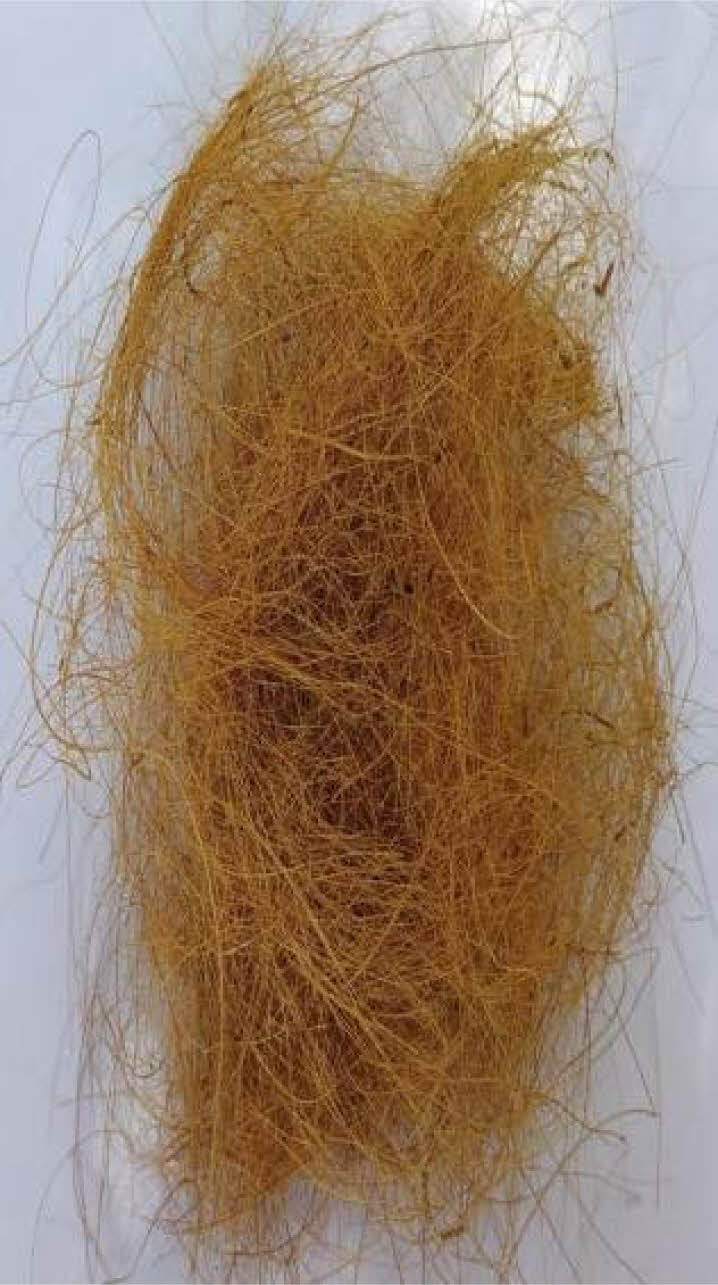
|
Fig. 2 Coir Fiber |
Mechanical Properties Test
In the first phase, concrete samples were subjected to mechanical testing in which ceramic waste powder was substituted for 20%, 40%, 60%, and 80% of the cement to find the optimal content of ceramic waste powder that produces the highest strength results. In the second phase, amount of coir fiber at 0.5 to 2% for the manufacture of concrete cubes specimens, cylinders, and prisms while maintaining a consistent amount of ceramic waste powder for the best mix discovered through trial experiments.
Durability property tests
Acid Attack on concrete
Cubes and cylinders were subjected to sulphuric and hydrochloric acid exposure, rapid chloride penetration test during laboratory comparison experiments as part of the durability tests. These tests aid in determining how concrete degrades during extended exposure to a hostile environment. Chen et al. [12] said that an essential aspect that shows the resilience of concrete in a corrosive environment is the penetration of chloride ions.
The investigation adheres to ASTM C1012 [32] durability assessment methodology. The cylinders used for the sulphate attack experiments were 200 mm long by 100 mm in diameter, and they were submerged in a 5% Na2SO4 solution for 60 days. Before undergoing durability tests, the concrete samples were first given a 28-day water cure to mature them.
An indicator of the impact of the acid attacks was the loss in weight and strength in the concrete over the course of the time period. Every four weeks, the pH value was used to continually analyze the sulphate solution's concentration, which was then sustained by adding 0.1 N H2SO4 on schedule. The solution was continuously stirred during the procedure to prevent salt buildup in the container. The ASTM C1202 [33] standards were followed when performing the rapid chloride penetration test.
Mechanical properties
Based on preliminary research (Figs. 3-5), where ceramic waste powder contents were varied at 20, 40, 60, and 80% as cement replacements, it was discovered that only 20% of the ceramic waste powder substitution gave higher compressive, split tensile and flexural strength than other mixes at a 28-day curing regime. Fig. 3-5 shows the compressive strength, split-tensile strength and flexural strength results of control and ceramic waste powder concrete. Fig. 4
On a general note, the compressive strength at 7 days of age did not significantly improve with the addition of ceramic powder. This might be explained by the absence of a hydraulic reaction in ceramic waste powder. Additionally, the key factor that contributed to its early strength was its capacity for microfilling. Given that the ceramic waste powder inclusion level was higher than 20%, a modest drop was seen. This might be explained by the dilution effect, which reduced the growth of strength, according to the research by Amr S. El-Dieb and Dima M. Kanaan [1]. Pozzolanic components, which can react with calcium hydroxide in the presence of moisture to generate additional cementitious compounds, are frequently present in ceramic waste powder. This improved the concrete matrix’s bonding and densification, thereby increasing split tensile strength.
As a microfiller, CWP can fill spaces between bigger aggregate particles. As a result, the stress within the concrete may be distributed more uniformly, thereby enhancing flexural strength. By improving particle packing inside the concrete mix with the inclusion of ceramic waste powder (CWP), density and porosity can be increased This denser matrix improved the concrete’s flexural strength.
In Fig. 6, it was discovered that the sample of coir fiber reinforced concrete with 1% coir fiber content and 20% ceramic waste powder had the highest 28 days ‘compressive strength. Srinidhi et al. [11] found that coir incorporation levels of 0.5-1.5%, the compressive strength of average strength concrete rose by 20-25%. The particle packing within the concrete mixture can be improved by the use of ceramic waste powder. Greater density and fewer voids in the concrete are produced via improved particle packing, which is associated with greater compressive strength.
The concrete matrix is reinforced with coir fibers. This reinforcement stops cracks from forming and spreading, which enhances compressive strength in the end. The connection between cement particles and aggregates can be strengthened by using coir fibers and ceramic waste powder. A more cohesive and dense concrete matrix is produced as a result of this better bonding, which helps to increase compressive strength. The fibers in the composite material have the potential to stop cracks from starting and spreading. The coir fibers add to the material's total compressive strength by dispersing stress and halting the formation of cracks.
Figures 7 and 8 shows the tensile strength and the flexural strength of the concrete with coir fibers. It was found that a mix of 1% coir fiber and 20% ceramic waste powder had higher strength qualities in split tensile and flexural strength. When the coir fiber content exceeded 1%, the strength qualities deteriorated. Coir fibers and waste ceramic powder can modify the microstructure of the concrete matrix, forming new interlocking phases and creating better bonding interfaces. These changes can positively influence the split tensile strength. The coir fibers with ceramic waste powder help to more evenly distribute stress when they are introduced to the concrete mix, which increases the material's tensile strength and resistance to breaking.
The combination of coir fibers and ceramic waste powder enhances the cohesion between the matrix and aggregates, leading to improved bonding and a more stable concrete structure. This cohesion contributes to increased flexural strength.
Durability properties
Selected concrete compositions' resilience to harsh environments (control concrete; concrete with a 20% replacement of ceramic waste powder; and concrete with a 20% replacement of ceramic waste powder with an addition of 1% coir fiber) have been assessed.
Tables 3 shows the concrete weight loss in following exposure to sulphuric acid and hydrochloric acid attack. When compared to combinations made with 20% replacement ceramic waste powder and 20% replacement ceramic waste powder with addition of 1% coir fiber, the weight parameter of the control concrete was dramatically reduced. Due to its high alkaline nature, the former was more vulnerable to acid attack; however, this effect seems to be mitigated by the addition of CWP to alter the composition. When exposed to acid, modified mixtures containing ceramic waste powder are more resistant than control concrete.
It was determined that the control concrete was more vulnerable based on the weight decrease after 60 days of exposure of an acid attack. The C-S-H gel that was present in the conventional concrete may be responsible for this outcome. Whereas in the modified mixtures (concrete with a 20% replacement of CWP; and concrete with a 20% replacement of CWP with an addition of 1% coir fiber) The C-S-H gel appears to be less, and concrete typically exhibits enough resistance to acid assaults.
The pozzolanic characteristics of CWP, in particular, can minimize permeability in the concrete. This may lessen the concrete matrix's susceptibility to acid damage by limiting the infiltration of acidic liquids. The microstructure of the concrete can be changed by the addition of ceramic waste powder, resulting in a matrix that is denser and more compact. By doing this, the concrete's overall chemical resistance and capacity to withstand acid assault can be improved.
The presence of coir fibers in the concrete produces a physical barrier that can obstruct acid flow and stop it from penetrating the substance. This barrier effect can stop an acid attack in its tracks and lessen its effects. Concrete cracking can be reduced with the aid of coir fibers. Acidic liquids can enter cracks and attack the concrete through them. Coir fibers help the material's acid resistance by decreasing crack initiation and spread. Lignin is a naturally occurring chemical compound that can function as an acid buffer and is found in coir fibers. By neutralizing the acid and lessening its corrosive effect on the concrete, the lignin's alkaline nature helps mitigate the impacts of an acid attack.
The charge passed in Coulombs, according ASTM C1202 [33] categorization for each of the chosen samples was within the range of 1386.58-1968.33, and it is possible to describe these samples as having low chloride permeability. Because of the low w/c ratio and the cement type utilized, control and modified mixtures' consistent chloride permeability may have been achieved. Amr S. El-Dieb and Dima M. Kanaan [1], investigated that the addition of ceramic waste powder to concrete mixtures resulted in considerable increases in the bulk electrical resistivity values and a high resistance to chloride ion penetration (RCPT), both of which indicate higher durability performance.
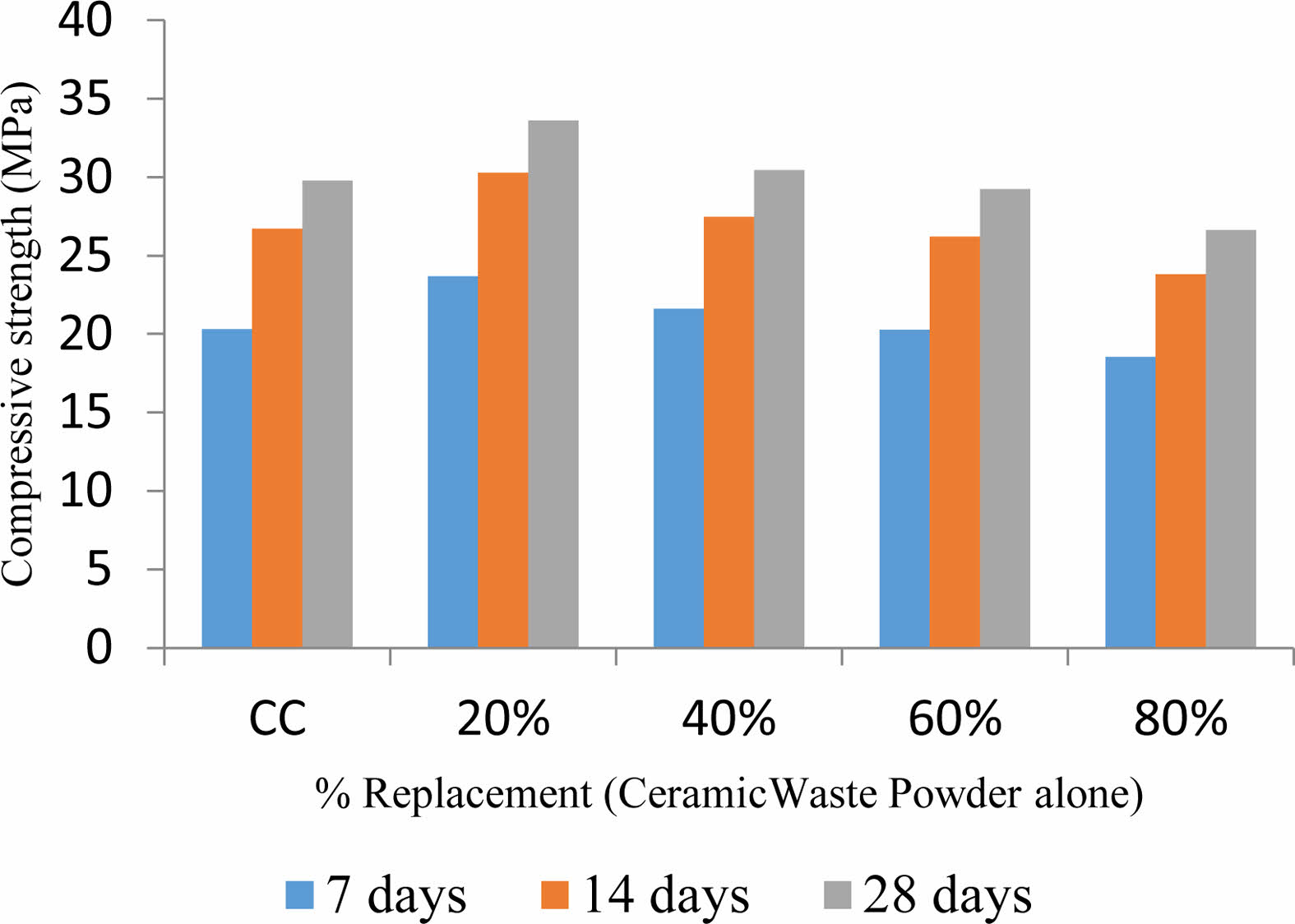
|
Fig. 3 Compressive strength of control and ceramic waste powder concrete. |
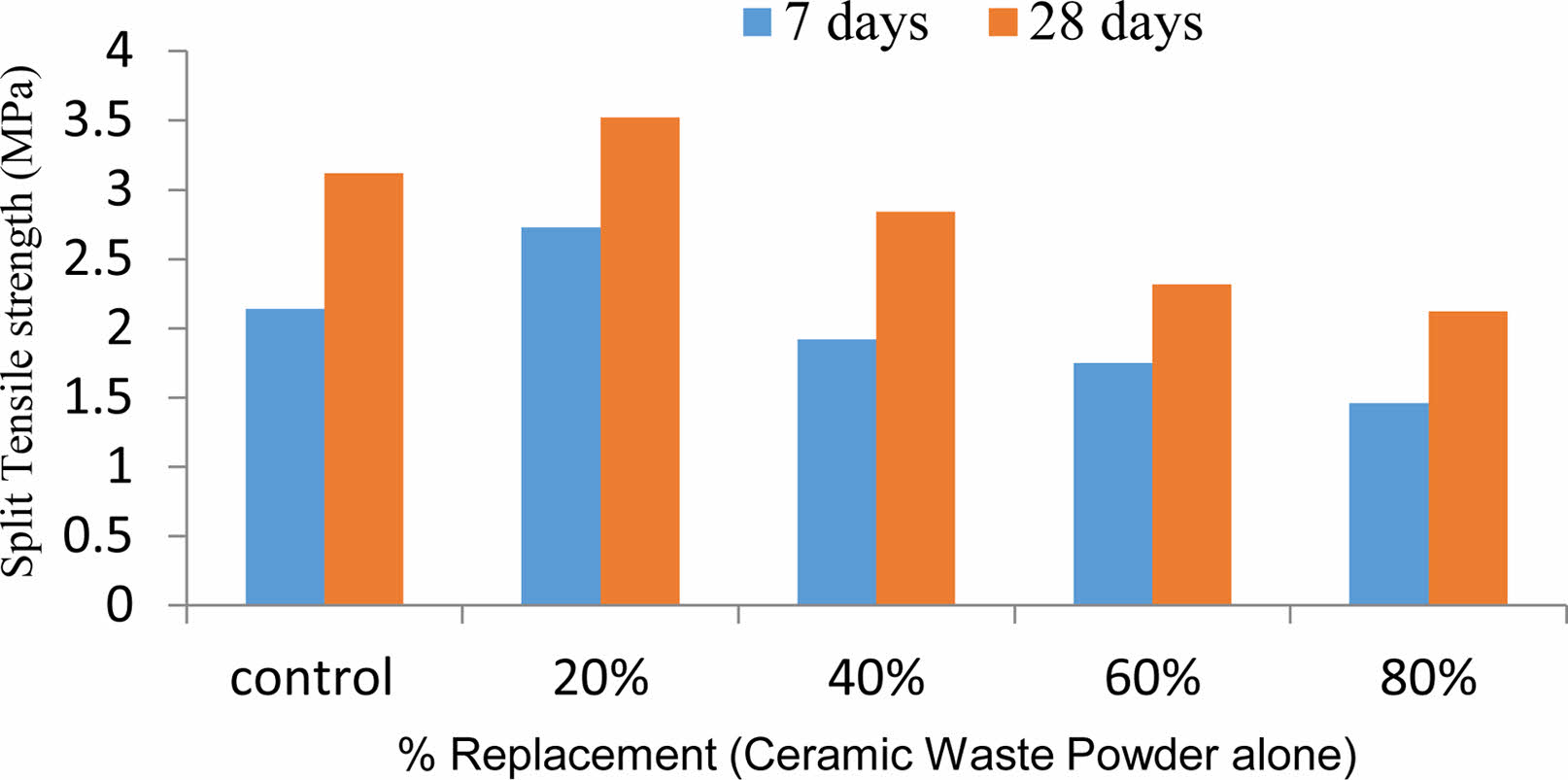
|
Fig. 4 Split tensile strength of control and ceramic waste powder concrete. |
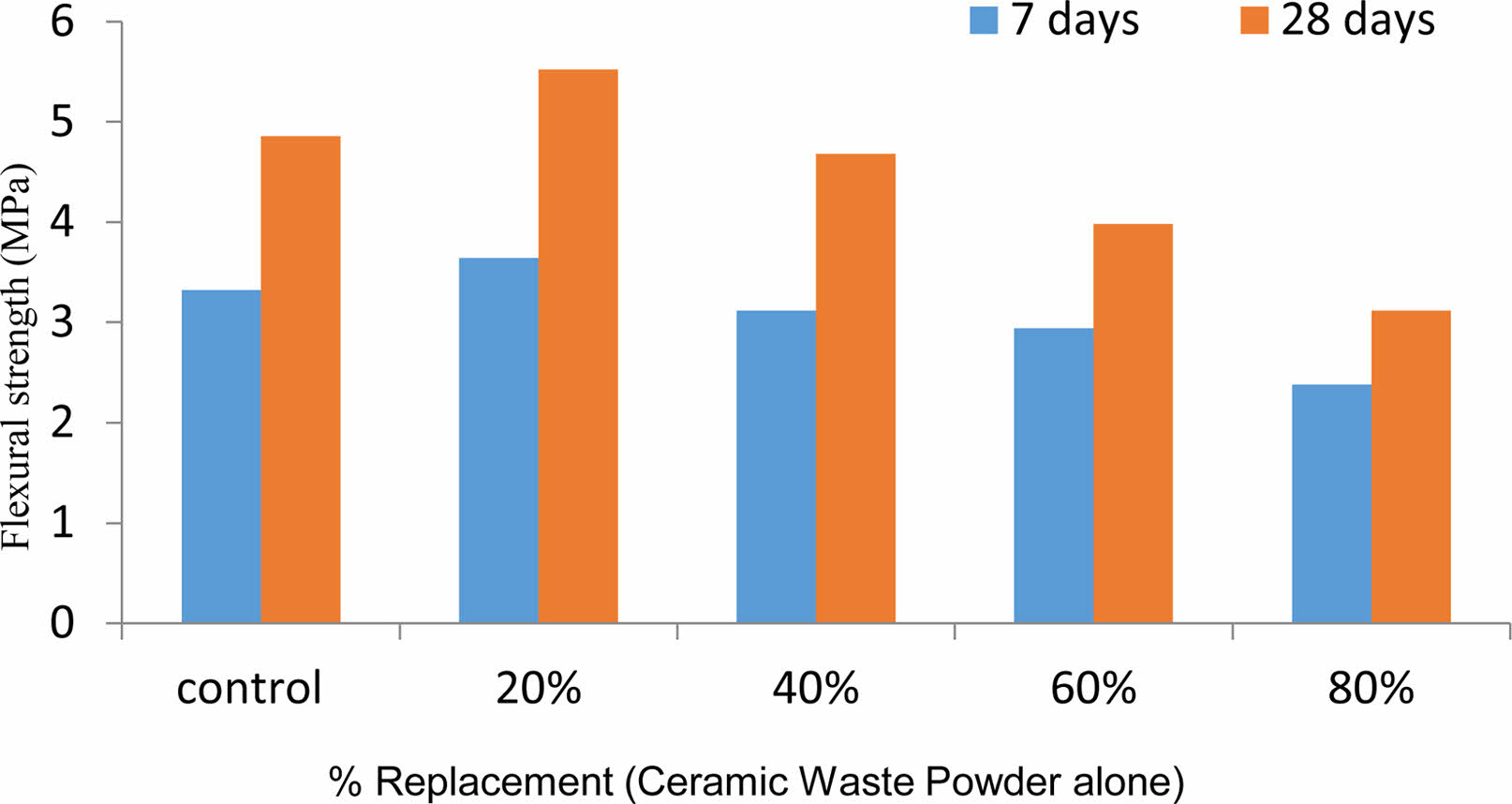
|
Fig. 5 Flexural strength of control and ceramic waste powder concrete. |
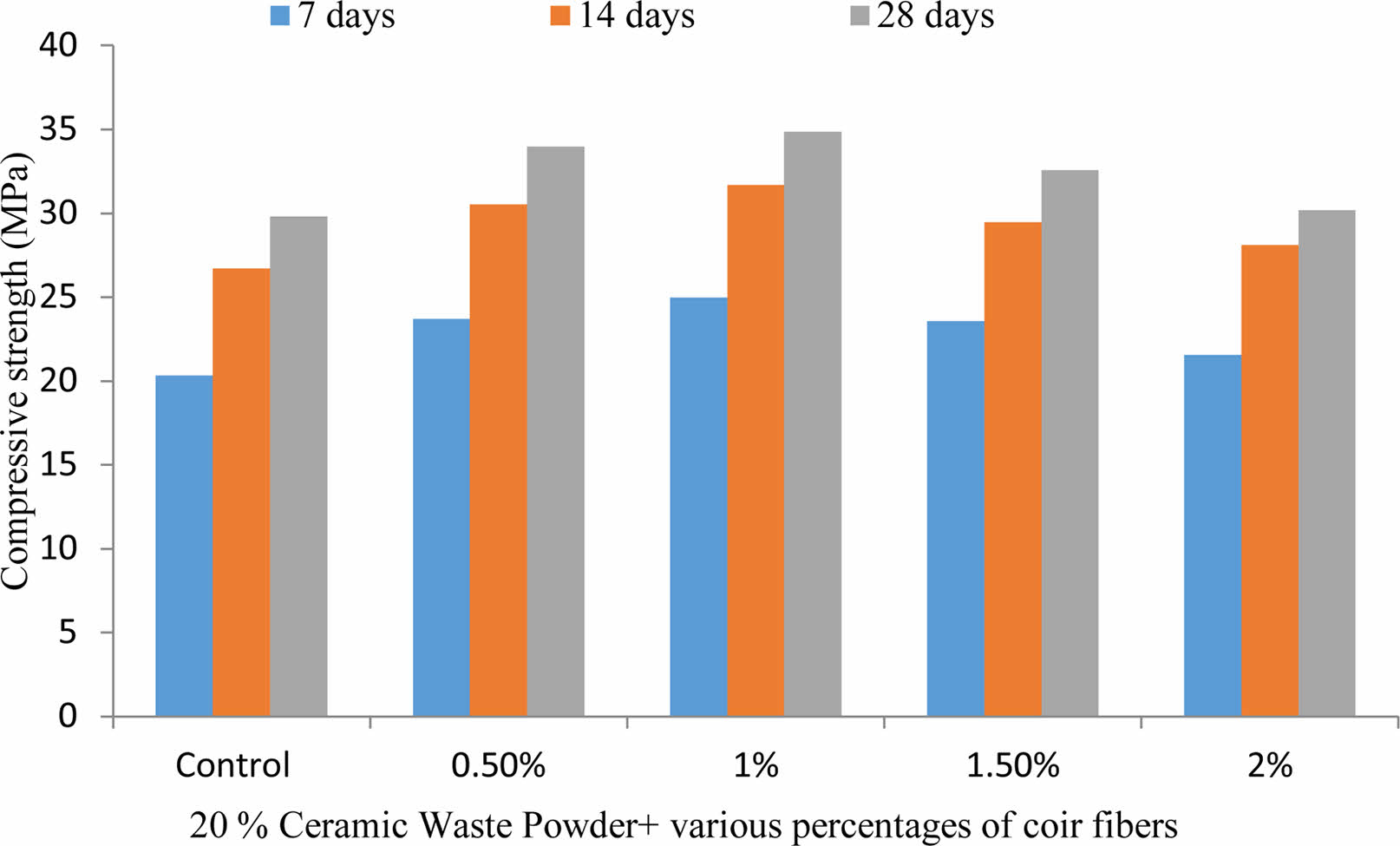
|
Fig. 6 Compressive strength of control and ceramic waste powder with coir fibers. |
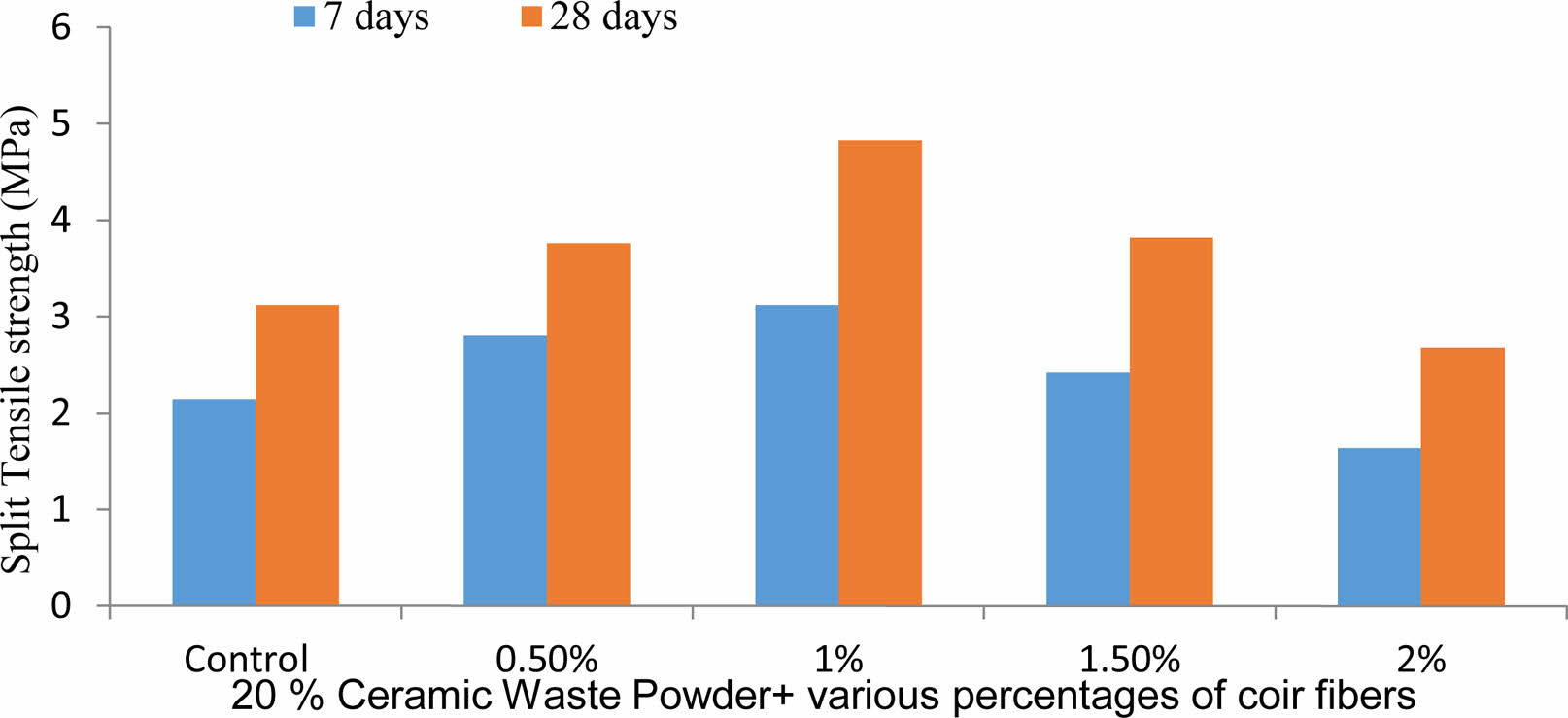
|
Fig. 7 Split tensile strength of control and ceramic waste powder with coir fibers. |
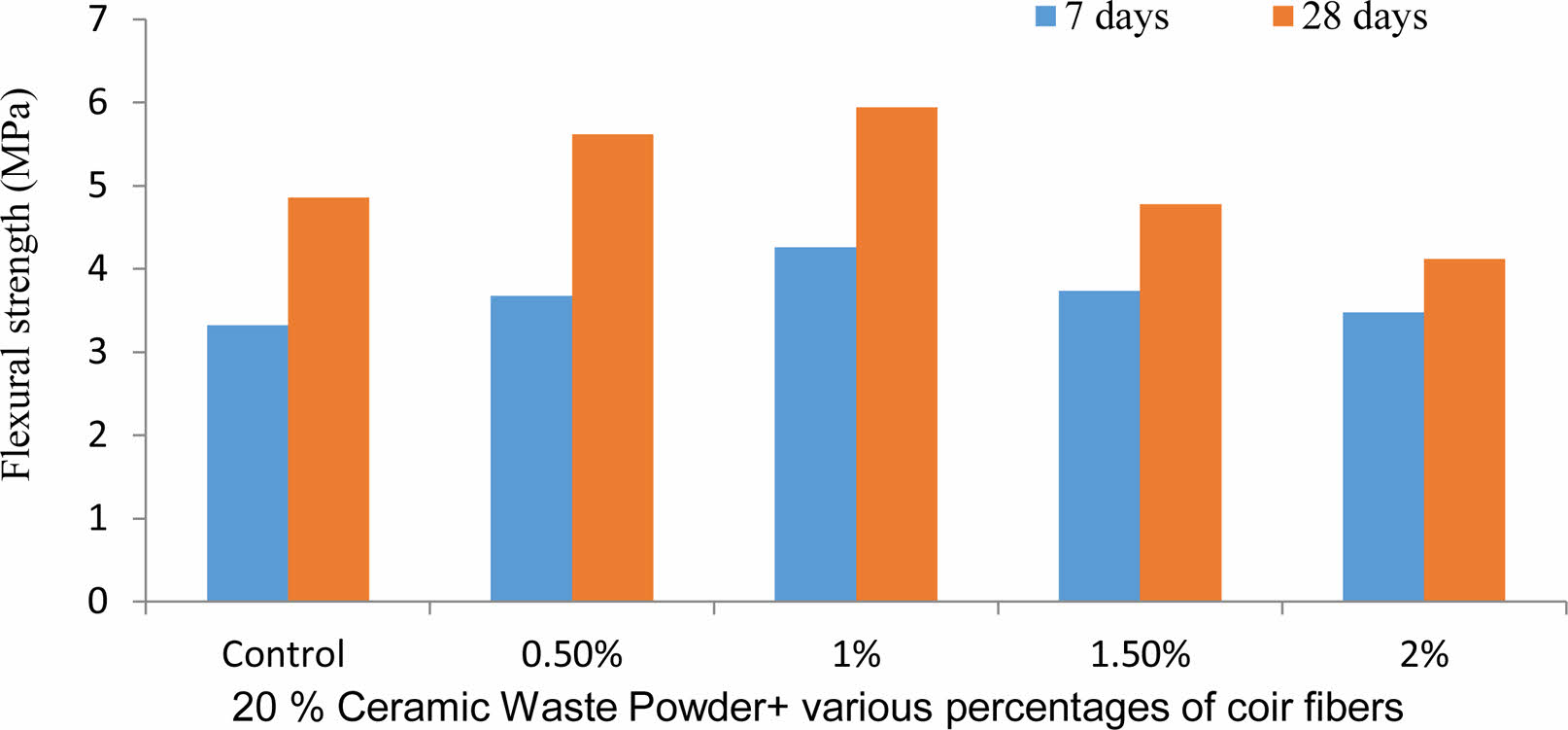
|
Fig. 8 Flexural strength of control and ceramic waste powder with coir fibers. |
The results of this investigation suggest that ceramic waste powder can replace cement in concrete and also coir fibers are added in the concrete since its mechanical and durability properties are well within the parameters set out by IS: 383-1970. Therefore, adding the ceramic waste powder and coir fibers to the concrete mixture is safe.
A preliminary experiment revealed that concrete's strength qualities were improved when 20% ceramic waste powder was used in place of cement. Further research has revealed that adding 1% coir fiber to concrete that contained 20% ceramic waste powder in place of cement resulted in stronger qualities than conventional concrete. The performance may be attributable to the effects due to pozzolanic of ceramic waste powder and the crack-reducing properties of coir fibers.
Comparison of compressive strengths of control concrete and 20CWP shows that when cement is substituted for 20% by the ceramic waste powder, the strength is confirmed to be 12.8% greater. Comparison of compressive strengths of control concrete and 20CWP + 1% CF shows that when cement is substituted for 20% by the ceramic waste powder and 1% addition of coir fiber, the strength is confirmed to be 16.97% greater.
The strength is confirmed to be 12.82% higher than
that of conventional concrete specimens while comparing the split tensile strength in control concrete and 20CWP with 20% substitutions of ceramic waste powder with cement. The strength is confirmed to be 37.17% higher than that of conventional concrete specimens while comparing the split tensile strength in control concrete and 20CWP + 1% CF with 20% substitutions of ceramic waste powder with cement and 1% addition of coir fiber.
When flexural strength in control concrete and 20CWP are compared, the 13.58% increase in strength over the conventional concrete specimen is confirmed by the replacement of cement with ceramic waste powder at a rate of 20%. When flexural strength in control concrete and 20CWP + 1% CF are compared, the 25.43% increase in strength over the conventional concrete specimen is confirmed by the replacement of cement with ceramic waste powder at a rate of 20% and coir fiber addition at a rate of 1%.
On studying the durability properties, it is noted that the replacement of cement by ceramic waste powder influences the weight loss parameters for concrete mixture. 20CWP + 1%CF specimens were exposed to acids; they were found to have higher resistance to acid attack resulting in lower weight loss compared to all concrete mixes.
The results of RCPT on all replacement levels of ceramic waste powder and coir fibres show a low permeability of chloride in the concrete samples. The charge passed in coulombs for the selected samples were within the range specified ASTM C1202.
- 1. A.S. El-Dieb and D.M. Kanaan, Sustain. Mater. Technol. 17 (2018) 63.
-

- 2. M. Harikaran, P. Kulanthaivel, A.R. Krishnaraja, and P.C. Murugan, J. Ceram. Process. Res. 24[2] (2023) 266-273.
-

- 3. Q. Shuying, Z. Bin, S. Chen, and L. Jin, The Open Civ. Eng. J. [8] (2014) 368-372.
-

- 4. L. Li, W. Liu, Q. You, M. Chen, and Q. Zeng, J. Clean. Prod. 259 (2020) 120853.
-

- 5. R.V. Meena, J.K. Jain, H.S. Chouhan, and A.S. Beniwal, Clean. Mater. 4 (2022) 100085.
-

- 6. S. Anandaraj, J. Rooby, P.O. Awoyera, and R. Gobinath, Constr. Build. Mater. 197 (2019) 862-870.
-

- 7. B. Ali, A. Hawreen, N.B. Kahla, M.T. Amir, M. Azab, and A. Raza, Constr. Build. Mater. 351 (2022) 128957.
-

- 8. B. Wang, L. Yan, and B. Kasal, J. Clean. Prod. 338 (2022) 130676.
-

- 9. H. Syed, R. Nerella, and S.R.C. Madduru, Mater. Today: Proc. 27[2] (2020) 1104-1110.
-

- 10. A.J. Babafemi, J.T. Kolawole, and O.B. Olalusi, J. Eng. Sci. Technol. 14[3] (2019) 1482-1496.
- 11. P. Srinidhi, K. Gokulapriya, and P. Parthiban, Int. Res. J. Eng. Technol. 6[4] (2019).
- 12. X. Chen, D. Zhang, S. Cheng, X. Xu, C. Zhao, X. Wang, Q. Wu, and X. Bai, J. Build. Eng. 52 (2022) 104418.
-

- 13. D. Sivabalaselvamani, P. Kulanthaivel, J. Yogapriya, and I. Dhanoa, J. Ceram. Process. Res. 23[6] (2022) 902-911.
-

- 14. S. Shanmughan, S.K. Kaliyannan, S. Marasamy, and P. Thiyagarajan, J. Ceram. Process. Res. 24[1] (2023) 111-119.
-

- 15. K.N. Fatema, H.M. Lim, J.S. Hong, K.S. Lee, and I.J. Kim, J. Ceram. Process. Res. 24[1] (2023) 197-204.
-

- 16. K.S. Kumaar, N. Muralimohan, P. Kulanthaivel, and S. Sathiskumar, J. Ceram. Process. Res. 23[6] (2022) 892-901.
-

- 17. S. Janani, G.S. Rampradheep, P. Kulanthaivel, and P.C. Murugan, J. Ceram. Process. Res. 23[6] (2022) 884-891.
-

- 18. M.A. Kumar, S. Balaji, S. Selvapraveen, and P. Kulanthaivel, Clean. Mater. 6 (2022) 100-156.
-

- 19. A.O. Tanash, K. Muthusamy, A.M.A. Budiea, M.A. Fauri, G. Jokhio, and R. Jose, Clean. Eng. Technol. 17 (2023) 100699.
-

- 20. Q. Chang, L. Liu, M.U. Farooqi, B. Thomas, and Y.O. Ozkilic, J. Mater. Res. Technol. 24 (2023) 6348-6368.
-

- 21. J. Yang, P. Jiang, R. Nassar, S.A. Suhail, M. Sufian, and A.F. Deifalla, J. Mater. Res. Technol. 23 (2023) 3676-3696.
-

- 22. A. Beyene, Y. Tesfaye, D. Tsige, A. Sorsa, T. Wedajo, N. Tesema, and G. Mekuria, Heliyon. 8[10] (2022) 10993.
-

- 23. C. Aksoylu, Y.O. Ozkılıç, A. Bahrami, S.A. Yildizel, I. Hakeem, N. Ozdoner, B. Basaran, and M. Karalar, Case Stud. Constr. Mater. 19 (2023) 02444.
-

- 24. B. Balegha, H. Sellafa, and A. Hadjmostefaa, Case Stud. Constr. Mater. 13 (2020) 00368.
 This Article
This Article
-
2024; 25(1): 41-47
Published on Feb 29, 2024
- 10.36410/jcpr.2024.25.1.41
- Received on Oct 5, 2023
- Revised on Nov 30, 2023
- Accepted on Dec 5, 2023
 Services
Services
- Abstract
introduction
materials and methods
methods
results and discussion
conclusion
- References
- Full Text PDF
Shared
 Correspondence to
Correspondence to
- S. Anandaraj
-
Assistant Professor, Department of Civil Engineering, KPR Institute of Engineering and Technology, Coimbatore – 641 407, Tamilnadu, India
Tel : 9524957886 - E-mail: pkulanthaicivil@gmail.com







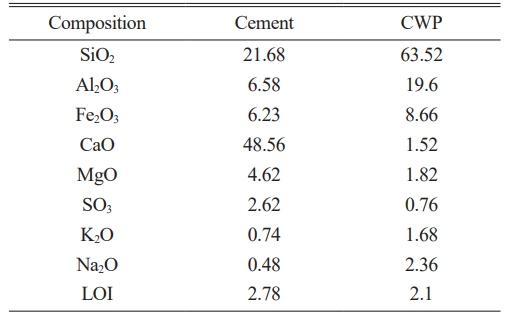

 Copyright 2019 International Orgranization for Ceramic Processing. All rights reserved.
Copyright 2019 International Orgranization for Ceramic Processing. All rights reserved.